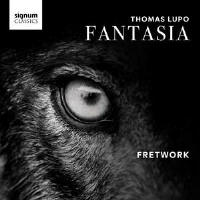Texte paru dans: / Appeared in: |
|||||||
|
Outil de traduction ~ |
|||||||
|
Reviewer: James
V. Maiello Thomas Lupo (1571–1627) was part of a prominent musical family active in England during the 15th and 16th centuries. Comprised of Sephardic Jews, the Lupo family was probably expelled from Spain in 1492; its members arrived in England from Italy in the early 16th century. Thomas was a violinist and viola da gambist, and he landed a position in the household of Prince Charles, a keen gambist himself. Many of the fantasias on this album are likely a product of this position. Fretwork presents a program here of works for three to six parts, of which the five and six-part fantasias are the most substantial. All things Italian were popular in England at the time, and it is easy to hear the influence of Marenzio and Vecchi in Lupo’s music, as well as that of his colleague Orlando Gibbons. Lupo’s writing blends dance styles with more serious contrapuntal writing that is evocative of both secular and sacred vocal music. Although this is just an uncorroborated observation on my part, one of the most fascinating aspects of Lupo’s music is the interaction between the refined style of the court viol consort and the virtuosic and sometimes earthy violin style of the late Renaissance and early Baroque periods. This is perhaps unsurprising given that English musical tastes of the period were in transition, with the popularity of the viol waning slowly in favor of the violin, which was emerging as a prominent instrument for music at court.
Celebrating its 35th anniversary in 2021, Fretwork continues to be arguably the leading viol consort active today; this recording is the latest in a discography that is as impressive in quality as it is in volume. The players prove ideal interpreters of Lupo’s intricate and often inventive music, negotiating subtle shifts in style and mood adeptly. They move easily between the regularity of the dance styles and the metric ambiguity of the contrapuntal writing. As one has come to expect from Fretwork, the technical playing is pristine and sounds unforced throughout. The players also effect a nuanced ebb and flow in the phrasing, especially in the more contrapuntal sections. They play off each other naturally with an easy, conversational style that is perhaps partly a result of working together for so many years. Throughout the program, the ensemble maintains an understated, sophisticated approach. This is not to say that the performances are bland; far from it. On the contrary, this allows individual voices to be heard clearly in the texture and brings out Lupo’s delicate gestures without being showy. The recorded sound is excellent. The sound is intimate but not harsh and the stereo mix is realistic and natural. This is some of Fretwork’s best work. Highly recommended.
| |||||||
|
|||||||
|
|
|
||||||
|
Cliquez l'un ou l'autre
bouton pour découvrir bien d'autres critiques de CD |
|||||||




